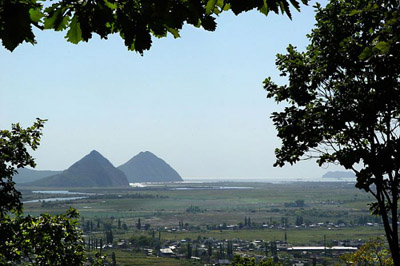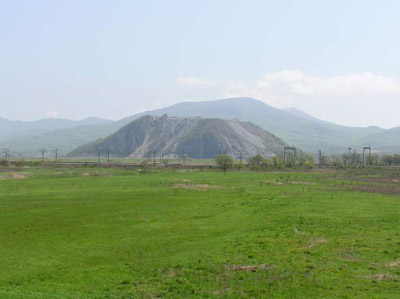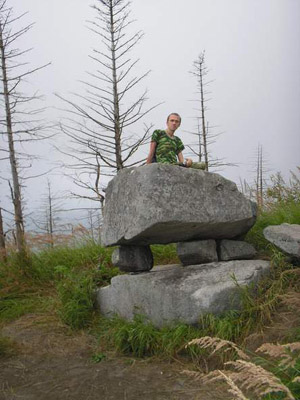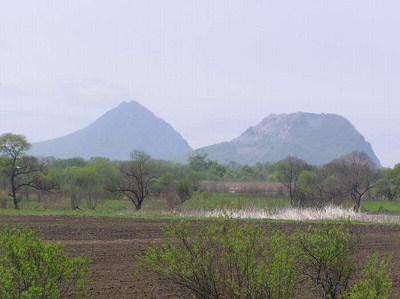|
from PhilipCoppens Website
The Russian city of Vladivostok harbored the main naval base of the Soviet Pacific Fleet, which meant that the city was closed to foreigners during the Soviet years.
Its military status meant that it was an ideal location for the Strategic Arms Limitation Talks in November 1974 between Leonid Brezhnev and Gerald Ford, one of the few occasions Westerners got to see a bit of the area.
The “hinterland” around Vladivostok is even more difficult to reach; it is nevertheless the region where one young Russian student, Maxim Yakovenko, thinks he may have discovered a geological feature that is anomalous – if not a pyramid.
Worse – or better – there are two such structures, next to each other, at the mouth of a river.
The suspected pyramids are located in the vicinity of Nakhodka, which became the primary deep water port in the Russian Far East when Vladivostok was closed off to foreigners between 1950 and 1991. Near the mouth of the Partizanskaya river, two hills display a pyramidal form. They are named Sestra (Sister) and Brat (Brother).
Their older names were Da-nai-shan (now Sestra) and Er-nai-shan (now Brat). In those days, the local settlers believed that the hills had been built, “a long time before”, but they did not know by whom.
Though few now come to pray, locals still claim that they feel happy and healthy on these hills, and when Brat was devalued to a stone quarry, the population of Nakhodka seemed to hold this act of desecration responsible for a bad patch of weather that hit the city.
The all-important question is: are we confronted with two sanctified natural hills, or man-enhanced structures?
In favor of a deliberate human intervention to make these hills into pyramids is that the sides of both hills are orientated towards the cardinal points – like most man-made pyramids, including the famous Egyptian ones.
Speaking to the local population, Yakovenko learned that many people knew of or believed in such inner structures. There was even a legend that said that statues could be found inside. And in the 1950s, archaeologists found some amazing artifacts in the vicinity of Brat. These excavations were actually stopped when the hill became a quarry in the 1960s.
He adds that if this was an ordinary stone quarry, the work would have begun at the foot of the hill, not on the top.
Whether manmade or natural, these two hills are not the only sacred hills.
Another sacred mountain, this time 70 kilometers from Vladivostok, is Mount Pidan, rising to a height of 1333 meters, which reveals its sacred nature by the presence of stone walls, dolmen and standing stones on its slopes. Though none of these structures are too impressive, they do betray tell-tale signs of human intervention. The wall is located at a height of 1050 meters and measures three to six meters in height and 350 to 400 meters in length, and runs almost perfectly straight.
What is more, the dolmen is situated at the beginning of this wall, perhaps suggesting that the wall separated a sacred from a profane area.
The local people reported to Arseniev that she was the soul of the wife of the ancient priest who was the custodian of Pidan. As can be expected, the legend comes in a number of variations, one of which is that when the priest was killed, his wife suffered his loss so much that she died soon afterwards. However, her soul never ascended to heaven and, either intentionally or unintentionally, she – or her soul – then became the supernatural custodian of the mountain, following in the footsteps of her husband.
No doubt, the legend was concocted to
explain some anomalous sightings on, around and above the mountain;
her spirit is said to have appeared in the forest, or near the river
and to do this day, people report sightings of “her”; some even
report that the phenomenon was captured on video.
The valley around Brat and the Partizanskaya river is rich in shards of old jugs and dishes. In fact, the valley is known as the “Golden Valley” (“Zolotaya Dolina” in Russian) and residents, amateur and professional archaeologists have stumbled upon dozen of ancient dishes and plates; one man even created a small museum, in the village of Sergeevka, putting some of his findings on display.
Apart from mentioning their existence, he posited a possible connection with Korean pyramid-like structures.
The majority of these Korean pyramids, like the Andong step pyramid, which is one of those that has withstood the test of time the best, are clearly man-made structures, but on a much smaller scale than Brat.
However, these Korean pyramids do prove that the concept of the pyramid as a sacred structure were known in this region, and this would thus make the Nakhodka structures anomalous in size only.
Furthermore, we need to remember that
Arseniev wrote how people had come from China – another country that
has pyramids – and Korea came to pray her. There must have been a
good reason why these pilgrims came here, and whether natural or
man-enhanced, the twin pyramids seem the most likely reason for
their voyage.
This means that destructive quarrying will be more difficult to execute – but equally, that any archaeological exploration of the hills will have to jump through more hoops.
|



